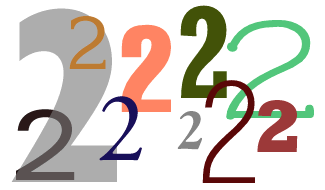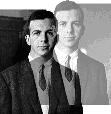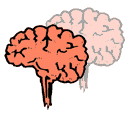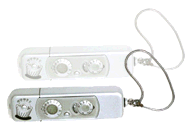
Wacky Conspiracy Theorizing
Double Trouble
In any real world criminal probe, or in any historical investigation (and the JFK assassination is both) we expect some of our evidence to be erroneous. Documents record "facts" that turn out to be untrue. Witnesses say things that are wrong, and sometimes downright wild.
But suppose you're not willing to write off documents and witnesses as mistaken. What kind of theories does that lead to? You start believing in two of everything.

Two Oswalds
The evergreen theory of this kind is the theory of "two Oswalds." There are actually two versions. One notes that Oswald's height, as recorded in various documents throughout his life, varies a bit. Several documents, mostly written before he defected to the USSR, list his height as five feet nine inches. Several other documents, mostly written after he returned, list his height as five feet eleven inches. Further, photos of Oswald show considerable variation in his appearance, physique, and hairline. What's the obvious inference? That one "Oswald" went to Russia, and that another different one, perhaps an intelligence operative, returned.
Another version is based on the fact that various witnesses reported seeing Lee Oswald in the weeks before the assassination in locations where the Warren Commission said he could not have been. He was seen by several witnesses in Alice, Texas looking for a job, at the at the Sports Drome Rifle Range in Dallas
engaged in target practice, in Irving, Texas having a scope mounted on his rifle, and numerous other places. What's the obvious inference? That there was one or more Oswald "look-alikes" impersonating our boy Lee, perhaps in an effort to "set him up" by creating a damning trail of witness testimony. Indeed, that is a reasonable inference if we don't believe that a case like this will create a whole raft of bogus sightings.

Two Kennedy Brains
If one wanted to collect a rich harvest of mistaken testimony, talking to witnesses 30+ years after the assassination would seem to be a good way to do it. And indeed, when the Assassination Records Review Board interviewed the JFK autopsy witnesses in the 1990s, they got several "interesting" bits of testimony.
For example, witnesses were shown autopsy photos of Kennedy's brain. Most of the witnesses said the brain looked like the one they remembered, but FBI agent Francis X. O'Neill said the brain he saw at the autopsy was much smaller than the one he saw the night of the autopsy. Further, the autopsists disagreed as to when the supplemental examination of the brain happened. J. Thornton Boswell and James Humes
said it happened two or three days following the assassination, and Dr. Pierre Finck said it happened on the Friday a week after the assassination.
One could conclude from this that three decades-old testimony isn't very reliable. But ARRB staffer Douglas Horne concluded that there were two different brains.

Two Coffins
The theory of two coffins is part of author David Lifton's theory that Kennedy's body was waylaid between Parkland Hospital and the autopsy in Bethesda and mutilated to make it appear that all the shots that hit him were fired from behind. Lifton reports, quite correctly, that Kennedy's body left Parkland hospital in an expensive burial casket. But a witness in Bethesda, one Paul O'Conner, told Lifton that the body arrived there in a plain shipping casket. Lifton views this as evidence that conspirators took the body out of the burial casket, altered the wounds, and then didn't bother to put it back into the same casket when they sent it along to the official autopsy. O'Conner also said that the body arrived in a body bag, and not in the plastic sheets in which it was wrapped at Parkland. The other witnesses disagree with O'Conner on both points, but Lifton accepts his testimony, the two coffins, and the body mulilation theory.

Two Minox Cameras at the Paine Residence
Of all the cameras one might own, the Minox is far and away the most "spooky." It has long been valued by spies because of its small size and high-quality optics. Thus the fact that there was a Minox camera at the Paine residence where Marina lived and Lee Oswald stored his possessions is hardly something conspiracists could overlook.
But did it belong to Lee Oswald, or to Michael Paine? Dallas police confiscated what they said was a Minox camera on the weekend of the assassination and sent it to the FBI, but the FBI said that what they received was a Minox light meter. Conspiracists say the FBI was lying and covering up, but can't produce any evidence other than the testimony of the Dallas cops that it was a camera rather than a light meter. If this is true, the FBI forged an elaborate paper trail of internal documents saying that they had a Minox case (not a camera) and a light meter.
To complicate matters, Michael Paine clearly owned a Minox camera, but he said he gave it to the FBI in January of 1964. A Minox camera remains in the National Archives to this day, but is it Lee Oswald's, or Michael Paine's? Film from a Minox camera was recovered from the Paine residence on the weekend of the assassination, and when developed it contained photos taken by Paine. The Dallas police inventory lists a Minox camera, a case for a Minox camera, and rolls of film from a Minox camera, but not a Minox light meter. But the relevant Dallas Police evidence photo shows a Minox light meter among the items recovered. Did the Dallas cops fail to list to light meter, or did they call it a "camera?" If the latter, that would explain why the FBI claimed to have no camera, but rather a light meter. It's also the case that it would be easy to confuse a Minox camera and a Minox light meter.
This is a complicated issue, with lots of discrepancies in testimony and documents, but the most plausible conclusion is that the Dallas cops were simply wrong about recovering a Minox. Michael Russ, in his essay "Missing Minox or Major Mistakes?" concludes as follows:
While it is impossible to prove that an Oswald Minox never existed, the case that it did exist is based on incomplete records and 15 year old memories. There is no photograpic record of this other Minox, and there are only two rolls of film listed as being taken from the Paine residence. Upon seeing all of the photographs developed from this film, Michael Paine claimed that his camera had taken all of those photos. In that case it is unreasonable to accuse the FBI or anybody else of tampering with that evidence. Indeed, I have never heard a good reason why somebody would have had such an urgent need resort to such criminal activity.
Thus we seem to be left with one Minox, and not two.

Two Rifles
There is today in the National Archives in College Park, Maryland, a 6.5 mm. Mannlicher-Carcano rifle, serial number C2766, linked to Lee Oswald by an impressive array of evidence. But was this the rifle discovered in the Texas School Book Depository less than an hour after the shooting? Not surprisingly, many conspiracists insist that it wasn't, and that there was another rifle.
There are at least three versions of this theory.
- The Classic Version — this version begins with reports that the rifle discovered in the Depository was not a Mannlicher-Carcano, but a Mauser. All of these reports had a common origin: the identification of the rifle as a Mauser by Sheriff's Deputy Seymour Weitzman, who glanced at the gun as it lay on the floor amid a pile of boxes. This identification was repeated by other officers such as Eugene Boone, and picked up by the media. But J.C. Day of the Dallas Police Identification Bureau announced that the rifle was in fact a Mannlicher-Carcano. Was the Mannlicher-Carcano substituted for the Mauser in the chain of evidence?
- The LaFontaine Version — In their book Oswald Talked, the Ray and Mary LaFontaine accept the "6th floor Mauser" story, and then up the ante by concluding that two rifles were found in the Depository: a Mauser on the 6th floor, and a Mannlicher-Carcano on the 4th or 5th floor. Their sole source of the "lower floor" theory is a single witness. According to the La Fontaines:
Former AFT agent Frank Ellsworth, who participated in a second search of the book depository conducted after 1:30 p.m. on November 22, 1963, according to a Secret Service document, confirms that the Mannlicher-Carcano was found by a DPD detective on the fourth or fifth floor of the building, "not on the same floor as the cartridges." He adds: "I remember we talked about it, and figured that he must have run out from the stairwell and dropped it as he was running downstairs." (p. 374)
- The Groden Version — This theory, featured in Robert Groden's book The Killing of a President, is based on amateur movie footage shot by Ernest Charles Mentesana on the day of the assassination. The Mentesana film shows a brief scene of a cop with a long gun on a fire escape outside an upper floor of the Depository, and then cuts to a scene of several police officers huddled in a discussion. One of the officers has a long gun on his shoulder. Groden tells his readers that the film shows a rifle that was "reportedly handed down . . . from the roof to the seventh floor fire escape, and examined . . . on the street" (p. 66). Groden adds "this gun is not a Carcano, and has never been placed into evidence."
Of course, believing any of these accounts requires ignoring a lot of evidence. The rifle discovered on the sixth floor of the Depository was photographed in place by Officer Studebaker, and then its recovery was photographed on 16 mm. film by TV cameraman Tom Alyea. The rifle shown in the films is a Mannlicher-Carcano. Frank Ellsworth's story is admitted hearsay and is contradicted by literally every witness who testified about the recovery of the rifle. And Groden's "second rifle" is actually a shotgun of the kind that numerous cops had in Dealey Plaza. The officers are not "examining" it, but are merely gathered together having a discussion, with one officer holding the gun on his shoulder.
Carrying it Way "Two" Far
If the examples above aren't bad enough, author Harrison Edward Livingstone carries this kind of thinking to its illogical extreme. Livingstone has declared:
It is my opinion that there are two sets of evidence in the
assassination of John Kennedy, and that evidence has undergone a process
of continuing evolution throughout the years. . . . I think that there are
two versions of the Bronson film, two Zapruder films, two sets of autopsy
pictures, two acoustical tapes, and maybe more. Mistakes might have been
made by the forgers, but the overall purpose was as much to confuse the
evidence as to falsify it. We know that law enforcement in this case often
wrote two sets of documents — affidavits that say exactly opposite things
from the same witness. They were prepared for all contingencies. (Killing the Truth, p. 312.)
This is all quite convenient: Livingstone can declare that any evidence he doesn't like is from the "forged" version, and not the "real" version. But just how could Livingstone possibly be convinced that Oswald was guilty?
Conclusion
One of the central tenents of good theorizing is the Rule of Parsimony. One should always prefer a simple theory to a complex one if the simple one fits the data.
But it might seem that the conspiracy theorists need a more complex theory to fit the data. After all, there really is evidence of two Oswalds, two coffins, etc.
The problem comes if one tries to fit one's theory to the data when the data are erroneous. One then ends up with a theory that explains not only the "signal," but much of the "noise" too. That's a recipe for a convoluted theory, especially in a field where there is so much noise.
Dave Reitzes brought the Livingstone quote to this author's attention.
 Return
to Kennedy Assassination Home Page
Return
to Kennedy Assassination Home Page






